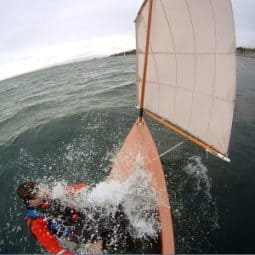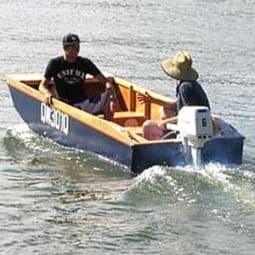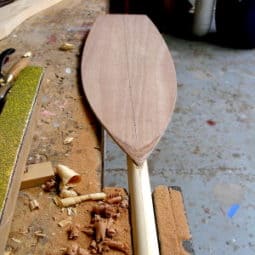If ply sheets are precoated before assmbling the boat it saves lots of time. Here are some guidelines, tips and techniques
It is easier to coat areas on the flat rather than when they are assembled into the boat because.
- Gravity works with you to keep the coated surface level so there can be no runs.
- It is easier to get an even distribution of epoxy on the surface.
- There is much less chance of missing a bit.
- Generally you can work standing upright rather than having to bend into inaccessible places.
- Because the epoxy it got out on the surface faster there is much less chance that the epoxy will cure too fast and go off before it is out on the surface properly.
- It is easy to apply the epoxy in three coats wet on wet or in applications rather than have to dewax and sand between every single coat.
Assembling a boat and the interior is already coated and sanded is a huge labour saving.
There are two main methods for precoating plywood with epoxy
Method 1 – coat panels without using masking tape, Make sure to remove any amine bloom (waxy residue) that is on the surface and sand ready to glue into the structure
Method 2 – place masking tape where components are going to be bonded. With some boat plans this is easy to do as there are reference lines for the internal structure. Make sure the tape is removed before the epoxy hardens – see method below.
Use Masking Tape to keep the panel tidy
This is Method 2 which is most peoples’ preference.
Here with one of our Quick Canoes. The masking tape is to keep the epoxy fillet tidy.

I find this the best method, where possible.
It saves the effort of sanding between coats of epoxy and prevents any waxing problems between the wet-on-wet coats.
Mask off all areas that you don’t want coated. (Especially any areas you are going to glue to later – not strictly necessary with some lower stressed designs like paddling canoes)

Tips and Techniques to consider before mixing epoxy
The only two reasons for epoxy not going hard are incorrect mixing or incorrect measuring. In 30 years of pro boat building and teaching and selling boat plans I’ve only ever seen two batches of epoxy that were wrongly formulated.
Why my epoxy has not gone hard and options.
First of all consider tools you are going to use to spread the epoxy. Tool selection is for speed and then for tidying up use a wide cut down brush.
Epoxy Application Tools including making your own
Also see this video. It is about glassing, but the same tools will be used. See how the focus is on spreading the epoxy out quickly.
Video on glassing an Oz Goose covers the same tools as will be used for coating.
First Coat of Epoxy on Plywood Surfaces
Lay surface flat where possible.
NOTE – To get a better finish – use the squeegee to spread out the epoxy so each layer is not too thick. Layers applied thinly (absolutely never ever add thinner!) are much less likely to get bumpy
NOTE If doing large areas the epoxy will go off too quickly if left in the mixing tin. You will have much more working time if you pour most of it out over the surface first and roughly spread with a squeegee, before going back with a roller to spread properly. Did you follow the two links in the section above?
Mix resin and hardener. You don’t need to add any powder when you are coating – they are only used when gluing one piece to another.
Apply first coat. Use a sqeegee, bought or homemade or large brush trimmed down.
If using brushes TRIM them so the bristles are only an inch 25mm long. This allows you to control the amount of epoxy more accurately. A full length brush applies too much epoxy and is too soft to push epoxy where you want it to go.

Even up the coat using the roller or cut down brush using light strokes – only add more epoxy to the surface if it seems dry or hard to spread. When it is spread hold roller so it cannot rotate and pull gently along surface of epoxy. It slicks the surface smooth and pop any air bubbles.
When first coat is tacky … then apply the second coat
What is tacky? If you put your gloved finger on the epoxied surface straight after application there is almost no resistance when you lift your finger from the surface. When the epoxy is tacky you will notice a distinct effort to lift the finger.
When first coat has become quite tacky, roll on second coat. Slick the surface.

Third Coat of epoxy on the Plywood hull panel and removing the Masking Tape
When second coat is tacky roll on third (recommended) and slick it down.
IMPORTANT Remove masking tape when third coat is still tacky. You don’t want to glue it down forever.
When epoxy is fully cured turn the panels over, sand off any drips that have come from the other side and repeat process if required. Usually we don’t precoat any surfaces that are going to make up the outside surface of the hull because that is easy to do later.
When the epoxy has cured dewax (if you don’t know the epoxy characteristics well I’d STRONGLY recommend it) sand the panels smooth using a random orbit sander (these tools are a very worthwhile investment but hand is fine too). 150 grit paper is about right. Sand enough to remove 95% of the gloss. Go over the rest quickly with handheld sandpaper to remove the last bit.
If you have problems getting a good finish speak to your epoxy dealer.



















